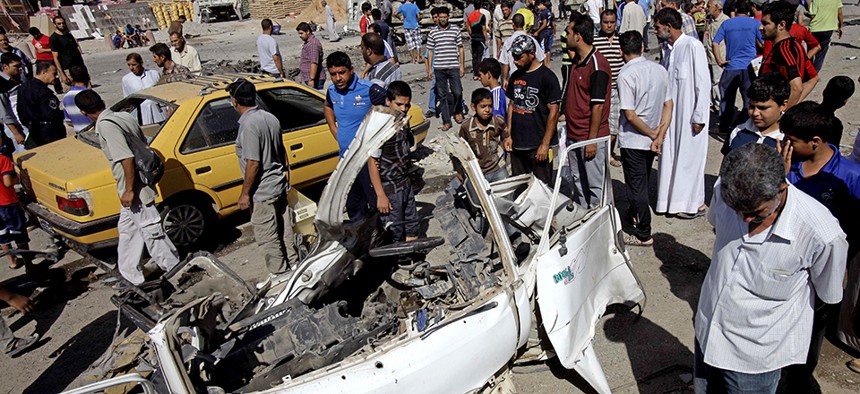
Iraqis walk around the aftermath of a car bomb attack in Sadr City, Baghdad Karim Kadim/AP
Iraq’s Descent Into Madness, With No Americans in Sight
Prison breaks, car bombs and cozying up to Iran? This is not what was supposed to happen. By Joshua Foust
How could al Qaeda in Iraq have become this powerful? Last week, the indefatigable terrorist group supposedly broken by the mighty U.S. military after an eight-year war instead broke into two prisons -- one of which is the infamous Abu Ghraib -- and freed nearly 500 prisoners. They killed 29 police and soldiers and wounded another thirty-five. It was the largest prison break in recent Iraqi history, and prompts a terrifying question for the U.S.: Now what?
Since the official withdrawal of U.S. troops from Iraq in December of 2011, Iraq has struggled with its own security. Civilian deaths climbed steadily in 2012 and 2013, and according to the U.N. Assistance Mission for Iraq nearly 700 died from terrorist attacks in June alone -- nearly three times the monthly average in Afghanistan.
In July, violence is yet again abnormally high, culminating this week with another wave of car bombs killing dozens of people mostly in Shiite areas.
Al Qaeda warned us this would happen. Last summer the leader of al Qaeda in Iraq, Abu Bakr al-Baghdadi, in an online audio statement said that his militants were rebuilding the strongholds once cleared by U.S. forces. "I bring you good news,” he said. “We are starting a new phase in our struggle with a plan we named `Breaking the walls,' and we remind you of your priority to free the Muslim prisoners."
"At the top of your priorities regarding targets is to chase and liquidate the judges, the investigators and the guards," he said.
Within a week, fighters in Hadid, just north of Baghdad, killed 19 people, including 12 policemen.
The prison break last week echoed another large prison break last September, when al Qaeda attacked Tasfirat jail in Tikrit and released 90 prisoners. Prison breaks are depressingly common in Iraq (September 2011 in Mosul; March 2012 in Kirkuk). But the scale of the most recent break is without precedent.
Scholars who study terrorist movements have noted before that prisoner releases can fuel jihadist violence. Writing in The Atlantic last year, Daveed Gartenstein-Ross of the Foundation for the Defense of Democracies and Aaron Zelin of the Washington Institute for Near East Policy argued that prisoner releases during the Arab Spring movement helped jihadi causes rebuild themselves. The sudden influx of jihadi fighters back on the street, they wrote, “has allowed jihadis to regroup, recruit and spread their message.”
Yet the wave of prison breaks also points to an institutional hollowness in Iraq that concerns many analysts. “By all accounts there is no way this break happened without inside help,” Michael Wahid Hanna, a senior fellow at the Century Foundation, told me. The sudden increase of insider-attacks at prisons around the country is deeply worrying for Iraq’s long-term political prospects. Yet it is impossible to look at Iraq’s rapid deterioration without considering Syria.
“The conflict in Syria has had an obvious impact on Iraq’s security,” Hanna says. A year ago, al Qaeda in Iraq was able to launch effective attacks but they were few and far between. Now, attacks happen almost daily and with devastating effectiveness. Something changed.
Complicating efforts to monitor the rise of al Qaeda’s Iraq branch is the openness of the border with Syria. Almost no one is closely watching the border, and it seems to be a primary conduit for sending men and materiel between the two countries. “The Iraq-Syria border was porous while we were still there,” Hanna says. “But we also aren’t monitoring it closely, so we have no idea who is moving across it and in what numbers.” Those analysts and governments who are monitoring the conflict in Syria are based in either Lebanon or southern Turkey, with a small number in Jordan.
There is reason to worry about last week’s prison break. Gregory D. Johnsen, an expert on al Qaeda in the Arabian Peninsula, wrote in 2009 about how a similar 2006 prison break in Yemen led to the creation of AQAP.
It’s too soon to tell if the Abu Ghraib break will be as consequential for Iraq. But the Iraqi government faces enormous challenges in responding to al Qaeda’s resurgence without additional outside help. Good intelligence, surveillance and reconnaissance are vital components to tracking and targeting terrorist groups in Iraq. Yet most ISR assets in Iraq were American-owned and withdrawn along with U.S. troops in 2011. As a result, the Iraqi government cannot be as precise in its counterterrorism operations and its blunter methods have the potential to make the security environment worse.
With Syria and Egypt also aflame, Washington’s Iraq response has been muted and scattershot. Over the last 10 months, there have been scattered reports that small teams of U.S. special operations forces have deployed back to Iraq in an advisory capacity. And the CIA is reportedly ramping up its presence and operations in Iraq to monitor and potentially to attack al Qaeda fighters slipping in from Syria. But American officials are increasingly frustrated by the Iraqi government’s inability (or refusal) to stop Iranian flights into Syria in support of Bashar al-Assad. Against this backdrop, Iraq is also seeking nearly $2 billion in military equipment from the U.S. What’s missing is a strategy.
“There’s a sense that we bugged out,” Hanna says. “Neither the embassy nor the Obama administration have done a very good job of communicating just what they’re doing and what their plans are.”



